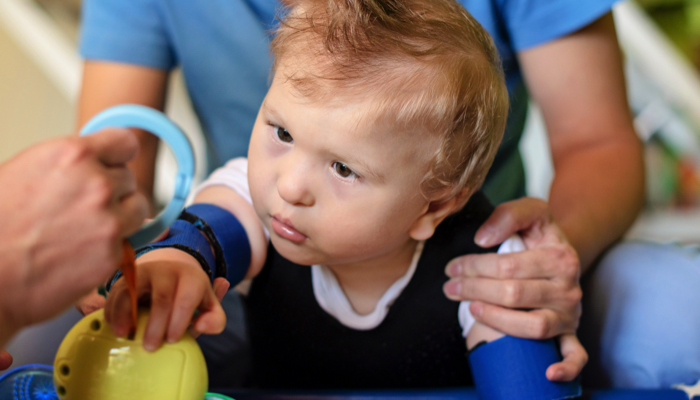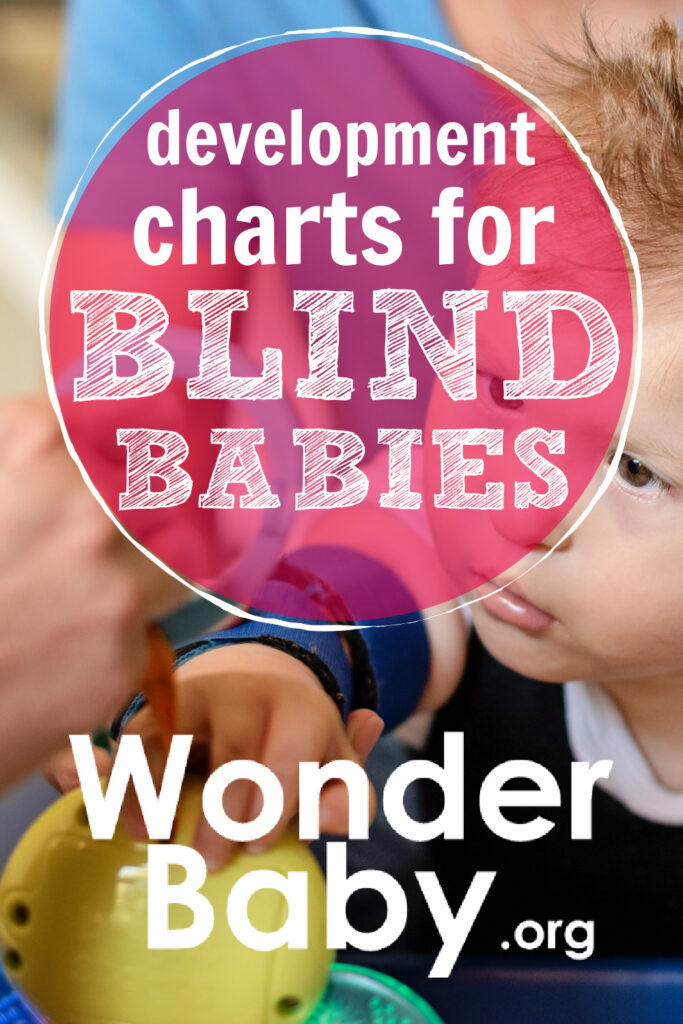Development Charts for Blind and Visually Impaired Babies and Children

This post may contain affiliate links; please see our terms of use for details.
Watching your child grow and fall behind traditional development charts can be difficult. You understand that it’s normal for blind babies to develop at a slower pace, but how slow is normal… and how slow is too slow?
We used three sources (Developmental Guidelines for Infants with Visual Impairment: A Manual for Early Intervention, Helping Children Who are Blind, and Children with Visual Impairments) to compile development charts in five different areas that tell you what skills your blind or visually impaired child should have at certain age groups:
These are, of course, just guidelines. Use these charts as a checklist so you can identify your child’s strengths and weaknesses. The goal here is that your child always moves forward. All children, especially those with special needs, develop at their own rate, but we always want to see them progressing. Talk to your doctor immediately if you notice your child regressing or moving backward.
Social and Emotional Development Chart for Blind and Visually Impaired Babies and Children
| Age Group | Milestones |
|---|---|
| Birth to 3 months | Recognizes caregiver’s voice Can be soothed by voice or touch Smiles when played with |
| 4 to 6 months | Initiates request for attention |
| 7 to 9 months | Differentiates between familiar & unfamiliar people Shows stranger anxiety Shows fear of separation |
| 10 to 12 months | Uses gestures Cries when caregiver leaves Begins to enjoy social games like peek-a-boo |
| 22 to 24 months | Imitates caregiver Plays alongside other children Asks others when needs help |
| 3 years | Enjoys helping around the house Likes to be praised after doing simple tasks Is aware of people’s feelings |
| 5 years | Plays with other children Understands rules Expresses many feelings |
Click here to download a printable version of the Social & Emotional Development Chart.
Communication Development Chart for Blind and Visually Impaired Babies and Children
| Age Group | Milestones |
|---|---|
| Birth to 3 months | Differentiated cries (has different cries for different wants) Responds to familiar voices Reacts to sudden sounds Ignores certain sounds & attends to others |
| 4 to 6 months | Turns toward sound Makes 3 different vowel sounds Imitates vocalization |
| 7 to 9 months | Produces vowel-consonant combinations (ex. ga-ga or ba-ba) Recognizes familiar sounds or phrases |
| 10 to 12 months | Uses gestures Responds appropriately to familiar requests Jabbers expressively Begins to name things |
| 13 to 15 months | Anticipates routines in response to a familiar request Uses 2 words appropriately |
| 16 to 18 months | Uses words to make wants known |
| 19 to 21 months | Uses 8 words appropriately Strings 2 words together (ex. “ma-ma bye-bye”) |
| 22 to 24 months | Uses 2 & 3-word sentences |
| 3 years | Understands most simple language Communicates clearly |
| 5 years | Talks about what he or she has done Asks many questions |
Click here to download a printable version of the Communication Development Chart.
Cognitive Development Chart for Blind and Visually Impaired Babies and Children
| Age Group | Milestones |
|---|---|
| Birth to 3 months | Recognizes primary caregiver Plays with rattle Cries when hungry or uncomfortable |
| 4 to 6 months | Turns toward sound Places objects in mouth Shows preference in play materials Reaches for object in contact with body |
| 7 to 9 months | Explores different textures Uncovers toy Pulls string to activate toy Searches briefly for object lost from grasp but not in contact with body Reaches for object based only on sound cue Places object in container upon request |
| 10 to 12 months | Moves or gestures toward you when called Locates fixed (constant) object (ex. Highchair, table, etc.) Puts many objects in container Learns that an object exists even if out of sight Works to solve simple problems Begins to understand cause & effect |
| 13 to 15 months | Uses 2 related objects (ex. strikes drum with stick) Uses object to perform social action (ex. brushes hair, puts on necklace, etc.) |
| 22 to 24 months | Matches objects Pays attention to activities longer |
| 3 years | Fits shapes into matching holes Sorts objects Takes things apart & puts them together |
| 5 years | Follows simple directions & does simple puzzles Understands counting |
Click here to download a printable version of the Cognitive Development Chart.
Fine Motor Development Chart for Blind and Visually Impaired Babies and Children
| Age Group | Milestones |
|---|---|
| Birth to 3 months | Plays with hands Uses hands for purposeful action Retains object placed in hand Plays with toys that produce sound |
| 4 to 6 months | Reaches for object in contact with body with 1 hand (rather than 2) Places objects in mouth Uses pads of fingertips to grasp small objects Transfers object from hand to hand Brings object to midline Pulls objects out of container |
| 7 to 9 months | Explores different textures Places object in container Pulls string to activate toy Plays pat-a-cake |
| 10 to 12 months | Places one peg repeatedly into hole |
| 22 to 24 months | Stacks large objects |
| 3 years | Uses hands for complex tasks Throws a ball |
| 5 years | Copies simple shapes |
Click here to download a printable version of the Fine Motor Development Chart.
Gross Motor Development Chart for Blind and Visually Impaired Babies and Children
| Age Group | Milestones |
|---|---|
| Birth to 3 months | Holds head steady while being moved Lifts head up when on belly Elevates self by arms when on belly (totally blind or light perception only babies may not do this until after they roll from back to belly) |
| 4 to 6 months | Sits with some support Rolls from belly to back, from back to belly Sits alone steadily Pulls to standing (while holding your hands) Moves forward through crawling, creeping, or any other method |
| 7 to 9 months | Pulls self to sitting position Pulls to standing position (using furniture) Sits down Attempts to walk (while holding your hand) Creeps forward on hands and knees 3 feet or more Takes coordinated steps (while holding your hand) |
| 10 to 12 months | Stands alone Bends down to pick up object Walks sideways holding on to furniture Walks alone (3 steps) Walks alone with good coordination (5 steps) Pushes small obstacles out of the way Walks about house or yard independently |
| 13 to 15 months | Moves around large obstacle Walks up stairs with help, down stairs with help |
| 22 to 24 months | Squats |
| 3 years | Runs, jumps, climbs |
| 5 years | Easily walks backward Hops on 1 foot |
Click here to download a printable version of the Gross Motor Development Chart.
Read this article in Arabic: حيوا-السيدة-العمياء

The information WonderBaby provides is not intended to be, and does not constitute, medical or other health advice or diagnosis and should not be used as such. Always consult with a qualified medical professional about your specific circumstances.
Related Posts

Eye Conditions and Syndromes, Visual Impairment
Neuralink Announces Plans to Restore Sight to the Blind with Brain Chip
Elon Musk’s company Neuralink has announced plans to begin human trials of its new “Blindsight” brain chip by the end of 2025.

Visual Impairment
The Gift of Understanding: How a Young Child Helps His Blind Father Navigate Life
When a parent is blind, it’s natural for people to wonder how their sighted child will adapt. Will they struggle to understand their parent’s needs? Will they feel burdened by...

Braille and Literacy, Toys, Visual Impairment
24 Braille Toys for Kids Who are Blind
Everything from alphabet blocks to raised line coloring pages and activity books to puzzles to card and board games... and so much more! And it's all in braille ready for...